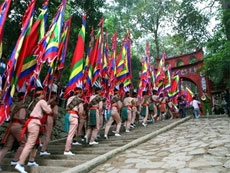The first Viet Tri City Street Festival, in the midland province of Phu Tho, begins a ten-day national commemoration of the Hung Temple Festival on April 14.

More than 3,200 artists from 13 districts and towns in Phu Tho Province and 18 other provinces and cities nationwide joined in a parade that ended up at the Hung Vuong Museum.
The museum, which has been built on a site of 15,000m², was inaugurated the same day.
On the occasion, the Deputy Chairwoman of Hai Duong People’s Committee Dang Thi Bich Lien presented the museum with two pottery vases made in the famous Chu Dau craft village and an embroidered picture.
During the ten-day festival, an exhibition of artifacts dating back to the era of the Hung Kings (approximately between 2897 BC and 1550 BC), the Ly Dynasty (1009-1225) and the Tran Dynasty (1225-1400) will be held.
Also on the occasion, 50 traditional pictures for worshipping are on display at the provincial Cultural House to respect the cultural spiritual values of Vietnam’s ethnic community.
The Culture and Sports Festival of the north-eastern ethnic groups began with 136 athletes from nine provinces taking part, namely Phu Tho, Bac Giang, Ha Giang, Thai Nguyen, Bac Kan, Cao Bang, Tuyen Quang, Quang Ninh and Lang Son.
According to legend, the Vietnamese nation, named Van Lang, was founded by Emperor Hung Vuong about 40 centuries ago. This dynasty lasted for 18 generations and led Vietnam towards development.
To honour the country’s founding fathers, the holy Hung Vuong site was built in 250BC in Phu Tho and has since become one of the most popular sites in the country. The annual Hung Kings anniversary is held on the 10th day of the 3rd lunar month.
The dynasty made many outstanding achievements including the founding of old Vietnam as an independent nation and the establishment of several institutions, administrative, social and economic, which made up the original Vietnamese nation.